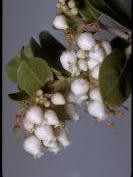Glossyleaf manzanita
(Arctostaphylos nummularia)

Description
Arctostaphylos nummularia is a species of manzanita known by the common names glossyleaf manzanita, dwarf manzanita and Fort Bragg manzanita. It is endemic to California, where it grows in the forests of the coastal and inland ranges north of the San Francisco Bay. Arctostaphylos nummularia is a red-barked shrub reaching a maximum height between one and two meters. The smaller twigs are covered lightly in white glandular bristles. The leaves are oval-shaped to nearly round, one to two centimeters long and wide. The edges are very finely toothed to nearly smooth, lined with tiny bristles, and sometimes curled under. The upper surface of the leaf is darker green and shinier than the underside. The inflorescence holds a cluster of hanging flowers, which are spherical and white to pink-tinged. The fruit is a cylindrical drupe less than half a centimeter long containing a few seeds. Arctostaphylos is a genus of plants comprising the manzanitas and bearberries. They are shrubs or small trees. There are about 60 species, of Arctostaphylos, ranging from ground-hugging arctic, coastal, and mountain species to small trees up to 6 m tall. Most are evergreen (one species deciduous), with small oval leaves 1–7 cm long, arranged spirally on the stems. The flowers are bell-shaped, white or pale pink, and borne in small clusters of 2–20 together; flowering is in the spring. The fruit are small berries, ripening in the summer or autumn. The berries of some species are edible. Arctostaphylos species are used as food plants by the larvae of some Lepidoptera species including Coleophora arctostaphyli (which feeds exclusively on A. uva-ursi) and Coleophora glaucella. Manzanitas, the bulk of Arctostaphylos species, are present in the chaparral biome of western North America, where they occur from southern British Columbia in Canada, Washington to California and New Mexico in the United States, and throughout much of northern and central Mexico. Three species, the bearberries, A. alpina (alpine bearberry), A. rubra (red bearberry) and A. uva-ursi (common bearberry), have adapted to arctic and subarctic climates, and have a circumpolar distribution in northern North America, Asia and Europe. An unusual association of manzanita occurs on Hood Mountain, in Sonoma County, California, where stands of pygmy forest dominated by Mendocino cypress are found.
Taxonomic tree:







